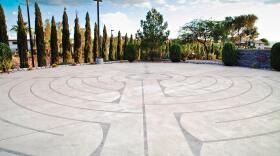The large-scale architecture that ought to engage the community too often doesn’t. Some of the blame falls on us
Southern Nevada’s real estate collapse was ugly and embarrassing — but it may also have been the best thing that could have happened to local architecture. Good design isn’t made by the limitless checkbooks and more-is-better thinking that were the norm during the boom years. Rather, it’s realized by innovation and creativity, vision and daring. Thanks to the recession, Las Vegas has a fresh opportunity to pause, rethink its priorities and begin to repair neglectful, damaging design made possible, in part, by a transient population of unengaged residents — particularly when it comes to the large-scale projects that do so much to define the city’s look and feel.
Unlike Las Vegans, residents of cities like San Francisco, Chicago and New York actively shape their communities through activism, shared civic pride and moral responsibility. Despite being half our size, San Francisco has an exponentially greater sense of community ownership. The Golden State Warriors recently abandoned a basketball arena along the Embarcadero thanks to growing public concern about traffic, environmental impacts and blocked Bay Bridge views. Now, a new, privately financed, $1 billion arena, which adds an adjacent park with water features, is being built in a more appropriate location. It will boast a distinctive disc-shaped design by Dutch super-firm Snøhetta, which also completed the National 9/11 Memorial Museum in Manhattan.
San Franciscans wouldn’t settle for less. Why should we? As Las Vegas aspires to become a truly great metropolis, it needs less indifference and more active community involvement in shaping this urban environment. Municipalities aid the public apathy by generally letting architecture, planning and context take a backseat, while approving anything that promises to ratchet up property values and create jobs, regardless of how unsuitable or ridiculous the scheme.
Henderson, for example, handed over 485 acres of public land for a proposed multi-arena sports complex that was more wishful thinking than potential reality. Envisioning a new level of sophistication, the city eagerly okayed a lopsided deal with developer Christopher F. Milam, who had tried three times, unsuccessfully, to build similar projects in Clark County and Las Vegas. This one failed, too. The scuttled deal wound up in a flurry of finger-pointing and lawsuits.
This is the wrong way to build an arena.
Meanwhile, MGM Resorts International is building a $375-million, 20,000-seat arena at Rue de Monte Carlo and Frank Sinatra Drive. The 650,000-square-foot venue, which broke ground May 1, is boutique by Strip standards. It was designed by the Kansas City architectural firm Populous, which also created the Fisht Olympic Stadium in Sochi, Russia, for the 2014 Winter Olympics. Unlike most arenas, which look like oversized salad bowls, the MGM venue will have an articulated and expressive facade that engages the surrounding environment, for a sense of dynamism and excitement. The Las Vegas Arena, as it’s being called, has expansive glass windows and an LED video overlay with a 145-foot-tall elliptical cladding on the south and west building faces, which evokes the color and sedimentary layering of the nearby Spring Mountains. The planned venue, expected to host up to 150 events a year, will boast a nightclub and a two-acre outdoor plaza. It debuts in the spring of 2016.
This is the right way to handle big architecture. It’s the same high-design approach that MGM embarked upon with CityCenter, its menagerie of sleek, expressive buildings arranged in an urbanist-like green campus. Although imperfect, CityCenter’s starchitect creations from Helmut Jahn, Cesar Pelli, Daniel Libeskind and Rafael Viñoly are elegant, refined and original. Stripped of theme and ornamentation, CityCenter strives to supplant the city’s otherwise crude and flashy public image with inspiring, world-class architecture. This is the approach to big architecture that the public ought to applaud but rarely does.
Perhaps that’s why oversized, neon-strewn, amusement-park-like temples aren’t likely to disappear anytime soon, as evidenced by Resorts World Las Vegas.
That is the new name for the unfinished Echelon Place, acquired last year from Boyd Gaming by the Genting Group, a Las Vegas neophyte. The Malaysian-based hospitality and gaming conglomerate plans to build a pagoda-themed resort on Echelon’s existing framework. It’s Disneyland meets Asia, with a water park, garden, panda exhibit and aquarium. Just the type of myopic family-friendly features that failed miserably in the 1990s. (The first components will arrive no sooner than 2017.) It’s a perfect example of mediocre, uninspired design deemed good enough because nothing better is expected. There is no public outcry, no financial consequences for setting the bar so low. Just because it’s on the Strip and intended for tourists is no reason to let it slide.
Las Vegas Sands spent $5.7 billion on Singapore’s Marina Bay Sands, employing famed architect Moshe Safdie to create a daring and innovative design. Completed in 2010, its three towers are connected at the top by a 3-acre sky park clad in metal panels. A portion of the park cantilevers 213 feet over the north edge of the building, like an airplane wing. It gives the gently sloping glass buildings directionality while creating a dramatic gateway element.
At home, however, Las Vegas Sands is content to do far less, throwing up big-box buildings with ersatz architecture. In fact, the gaming company put a tarp over an unfinished Palazzo condo project three years ago, and no one has raised a fuss since, despite its prominence on the Strip. Sure, Sands draws most of its income from China, but it’s still based in Las Vegas. Is this all we really ask from our buildings?
Seattle residents have the Space Needle; New Yorkers, the Empire State Building; San Franciscans, the Golden Gate Bridge; Chicagoans, the Willis Tower. What will occupy a similar place in the public psyche and hearts of Las Vegans? As the economy begins to pick up speed again, now is the time for us to pose and answer that question. Architecture can help forge a lively and resilient community character; it can establish a complex dialectic with our socio-cultural history and future. But we can’t leave it to developers and politicians. It will only be realized if we demand it.








